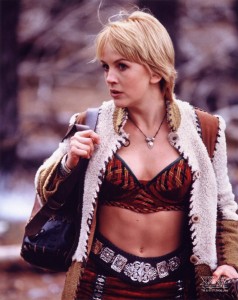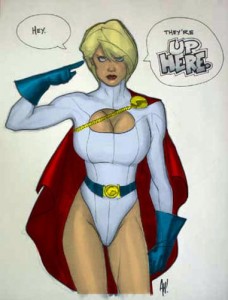 If you are to believe television and tech-savvy periodicals, being a nerd is cool and will make you rich and, as Tony Montana mused, then you get the money, then you get the wee-min. And yet life is hard for a code-pimp, or a cosplay enthusiast, or someone who shuns the light for the relative safety of thousands of hours of genre television.
If you are to believe television and tech-savvy periodicals, being a nerd is cool and will make you rich and, as Tony Montana mused, then you get the money, then you get the wee-min. And yet life is hard for a code-pimp, or a cosplay enthusiast, or someone who shuns the light for the relative safety of thousands of hours of genre television.
It’s not that nerds don’t love women, it’s just that a lot of them don’t know any real women. (An exaggeration of course. They know real women. They just have no capacity to talk to them?) Instead their days are spent wondering what it would be like to be married to Jessica Rabbit, or to have a blonde Cylon in your head. For all you little devils out there in Internet land who act out your nights as Hands Solo, this countdown is for you…ya little pervs.
Anyone who would then say this is totally sexist, let me say up front that I agree with you. For someone who has horrid social skills and is led to believe that the real world has any similarity to the fictionalized ones in movies, television, comic books, and video games, or that the only way for such a male to connect with a female is to contrive a way to “save her” as George McFly would save Lorraine from potential date-rapist Biff Tannen, this all must be terribly confusing. And so there will always be a subset of “dream women” for this particular demographic of Guyville. (And so many women love Ryan Gosling because he’s a fine actor.)
 10. Gabrielle – When writers are shooting for a well-rounded character that the audience can root for and identify with, they will often roll several characteristics into a single entity — smart, resourceful, attractive, and ruthless when needed to be. Things are done differently though when you have women characters, and even more different when you are writing for movies or television. For genre productions, producers tend to go less-fiery and savage and a little more on the sweet side to gain that rabid fan base of ultra-committed followers (aka: fanboys). It’s different in comics and video games where the characters, literally drawn, can do just about anything and that part of the male brain will accept it.
10. Gabrielle – When writers are shooting for a well-rounded character that the audience can root for and identify with, they will often roll several characteristics into a single entity — smart, resourceful, attractive, and ruthless when needed to be. Things are done differently though when you have women characters, and even more different when you are writing for movies or television. For genre productions, producers tend to go less-fiery and savage and a little more on the sweet side to gain that rabid fan base of ultra-committed followers (aka: fanboys). It’s different in comics and video games where the characters, literally drawn, can do just about anything and that part of the male brain will accept it.
But when seeing a human figure on the screen acting out, only a “tough woman” fetishist can be head-over-heels attracted to a character that could, and just might kill you. So that sexual connection isn’t as prevalent in characters like Sarah Connor in the second Terminator movie, and it isn’t fully there in the character of Xena, Warrior Princess. What to do?
You introduce a sidekick that can play up the more-feminine aspects to suit the majority segment. Renee O’Connor played that sidekick for six years on the syndicated TV series and was designed to be the yang to Xena’s yin. Xena would slice you in half with a downward stroke while Gabrielle would tend to your wounds and stroke your hair as you sweated out a fever. Gabrielle was, for all intents and purposes, the loving, loyal girlfriend the isolated fan would have dreamed of down in their comic-book-strewn bunker.
The relationship between Xena and Gabrielle, while never being fully confirmed on the show, took on aspects of lesbian couplehood. This was verbalized as being more than a hint by actress Lucy Lawless after the series was done. If that is indeed the case, then rather than just being a sword-and-sorcery TV show, Xena also was a milestone. When seen in this context, their relationship would have been a part of (but not the whole purpose of) their characters. It would have been one of the first depictions of a couple living their lives (hyperbolic though those lives may be) and they just happen to be a gay couple — it is a trailblazing moment in television because this is not included for the purposes of titillation, but of subtext.
 9. Power Girl – A cousin of Superman, the DC comic book character of Power Girl is, to be generous, a second-stringer. Yet as an emulated character at comic book conventions and such, Power Girl seems to rise among the ranks. There is a reason why. It is no big surprise that throughout the ’60s and ’70s, before the abolishment of the Comics Code Authority that mandated a rule of “decency” in the funny books, and long before the common proliferation of cable TV or the invention of the Internet, comics featured a sanitized sort of T&A for the little kids that didn’t want to jump into the convenience store dumpsters to fish out the discarded Playboys.
9. Power Girl – A cousin of Superman, the DC comic book character of Power Girl is, to be generous, a second-stringer. Yet as an emulated character at comic book conventions and such, Power Girl seems to rise among the ranks. There is a reason why. It is no big surprise that throughout the ’60s and ’70s, before the abolishment of the Comics Code Authority that mandated a rule of “decency” in the funny books, and long before the common proliferation of cable TV or the invention of the Internet, comics featured a sanitized sort of T&A for the little kids that didn’t want to jump into the convenience store dumpsters to fish out the discarded Playboys.
Superheroes of both sexes are drawn with exaggerated physiques and hardly ever obscured by clothing that masks shapes. It is, however, a bone of contention (pardon the pun) that male parts are de-emphasized while female parts are over-emphasized, but that also is because the majority of comic book artists are men. For them, the Power Girl character is a stand-out because she is the most voluptuous of the bunch (at least as far as the mainstream superhero genre goes).
So in the comic-fan realm where Storm is a valued take-no-prisoners asset to the X-Men, Wonder Woman is an Amazonian princess who fought beside the U.S. in an hour of need, and Vampirella and Red Sonja tend to be portrayed in hyper-violent and hyper-sexualized manner, Power Girl is somewhat a blank slate. She has curves and a costume, and that is about it. That open canvas is catnip to cosplay practitioners and the geeks who love them.
 8. Dr. Who’s Companion – Pick one, any one, except for Ace (an ass-kicking Sophie Aldred) who was brought in precisely because producers of the long-running sci-fi show were being accused of sexist tendencies toward The Doctor’s sidekicks. The companion, from the addition of Deborah Watling as Victoria with Second Doctor Patrick Troughton, largely served two purposes — look attractive and beguiling, and scream a lot and fall into jeopardy regularly. (Is that actually four? Whatever.) The Doctor also had male companions but they tended to be there when the actor playing The Doctor was older and couldn’t run and swing a punch like they used to.
8. Dr. Who’s Companion – Pick one, any one, except for Ace (an ass-kicking Sophie Aldred) who was brought in precisely because producers of the long-running sci-fi show were being accused of sexist tendencies toward The Doctor’s sidekicks. The companion, from the addition of Deborah Watling as Victoria with Second Doctor Patrick Troughton, largely served two purposes — look attractive and beguiling, and scream a lot and fall into jeopardy regularly. (Is that actually four? Whatever.) The Doctor also had male companions but they tended to be there when the actor playing The Doctor was older and couldn’t run and swing a punch like they used to.
Two of the more blatant companions dropped in for eye-candy were Zoe (Wendy Padbury) who liked spangly, tight jumpsuits and Leela (Louise Jameson, in what was viewed as the show’s “Pygmalion plotline”), a warrior woman who wore a leather loincloth. Invariably there would be a backlash and the producers would walk things back with companions who weren’t there solely for the dads watching after sports on Saturday night TV. Liz Shaw (Caroline John) was brought in as almost an equal to the Third Doctor (Jon Pertwee), certainly on an intellectual level, so her time in the series is noticeably brief.
The most successful companion was Sarah Jane Smith played by Elizabeth Sladen. She was first brought on as a reaction to Women’s Lib in the early-’70s, an independent woman and a journalist, and unfortunately was reduced to more of the victim/good screamer aspect as her time wore on. Nonetheless Sarah Jane balanced that smart/pretty/tough-when-needed blend the show desperately needed at that point and played alongside Fourth Doctor Tom Baker remarkably well.
Another successful companion was that of Romana, played by Mary Tamm and later Lalla Ward. Being herself a Time Lord, she was equal to The Doctor and could stand up against him, but also wound up in the screaming clutches of Daleks once too often. Tamm portrayed Romana as glamorous and statesman-like whereas Lalla Ward’s portrayal was more on the twee side. Behind the scenes, upon Romana’s departure, Tom Baker and Ward got married. It was a brief two-year marriage. She married her second husband, famed evolutionary biologist Richard Dawkins in 1992 and has been ever since (proving on a meta-scale that the science dude CAN get the girl in real life. There’s hope for us yet, poindexters!)
With the resurgent popularity of all things Doctor Who, the new companions have regularly broken that code of being the observer/prey-to-baddies and are his love interests more than not.
So who was my favorite? Sarah Jane, no question. Yes, she was tied up for ransom and sacrificial slaughter an awful lot. And yet there is a lot of attractive quality to Sarah Jane (by extension Sladen) in that although she was pretty, she felt more “real” than the majority of the characters in this fictionalized world. She stood by her convictions and would stand against The Doctor when necessary, but she was also a good friend to him. She started as a go-get-em adventure seeker, but the various writers allowed her character to grow tired of fighting and wandering, and her departure from the show stands as one of the most touching of the Doctor-companion separations. That is a credit to actress Sladen who brought a lot more to the role than expected or actually necessary. She passed away in 2011 at age 65, another victim of cancer. I would like to believe that I was never affected by this, and my nerdist tendency didn’t extend that far into that weird fan mentality…but Sarah Jane was more than another companion. She was “my companion.”




Comments